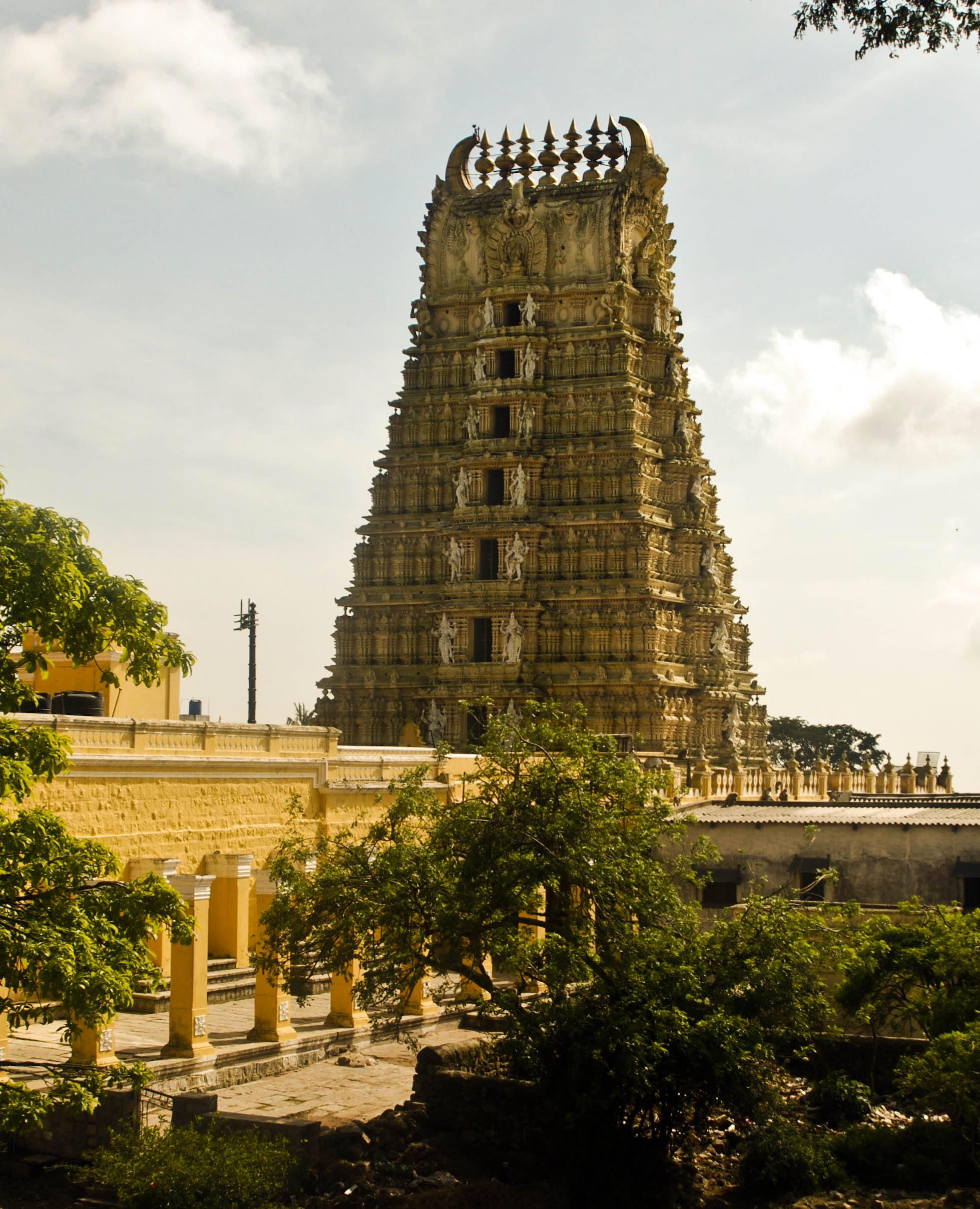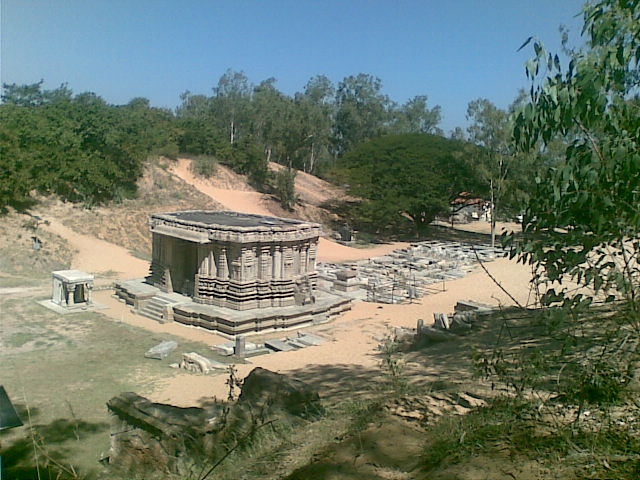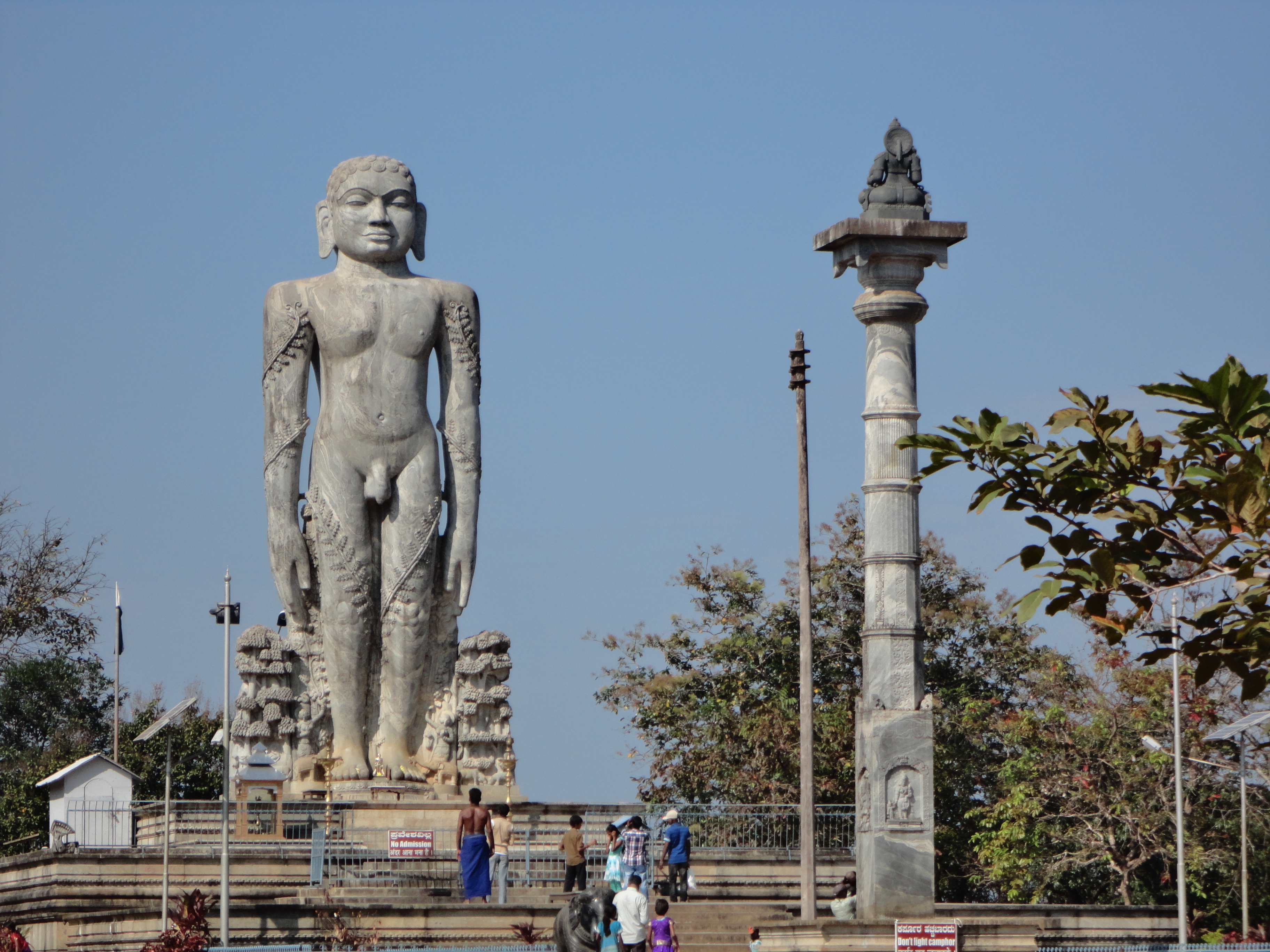|
Jain Temples, Halebidu
Jain hoysala complex in Halebidu, Hassan district consists of three Jain Basadis (Basti or temples) dedicated to the Jain Tirthankars Parshvanatha, Shantinatha and Rishabhanatha, Adinatha. The complex is situated near Kedareshwara Temple, Halebidu, Kedareshwara temple and ''Dwarasamudra lake''. The temple complex also includes a step well called ''Hulikere Kalyani''. These temples were constructed in the 12th century during the reign of Hoysala Empire along with Kedareshwara temple and Hoysaleswara Temple.Archaeological Survey of India has listed all three basadi in the complex in the list of "Must See" Indian Heritage and are also inscribed as one of the "Adarsh Smarak Monument". History Halebidu was the capital of the Hoysala Empire between the when Jainism maintained a strong presence in the region. The region was called Dorasamudra or Dwarasamundra during the rule of Hoysala. Bittiga (later became Vishnuvardhana), is considered the greatest ruler of Hoysala kingdom an ... [...More Info...] [...Related Items...] OR: [Wikipedia] [Google] [Baidu] |
Jainism
Jainism ( ), also known as Jain Dharma, is an Indian religions, Indian religion whose three main pillars are nonviolence (), asceticism (), and a rejection of all simplistic and one-sided views of truth and reality (). Jainism traces its spiritual ideas and history through the succession of twenty-four , supreme preachers of ''dharma''. The first in the current time cycle is Rishabhadeva, who tradition holds lived millions of years ago; the 23rd is Parshvanatha, traditionally dated to the 9th century Common Era, BCE; and the 24th is Mahāvīra, Mahavira, who lived . Jainism is considered an eternal ''dharma'' with the guiding every time cycle of the Jain cosmology, cosmology. Central to understanding Jain philosophy is the concept of ''bhedavijñāna'', or the clear distinction in the nature of the soul and non-soul entities. This principle underscores the innate purity and potential for liberation within every Jīva (Jainism), soul, distinct from the physical and menta ... [...More Info...] [...Related Items...] OR: [Wikipedia] [Google] [Baidu] |
Vaishnavism
Vaishnavism () ), also called Vishnuism, is one of the major Hindu denominations, Hindu traditions, that considers Vishnu as the sole Para Brahman, supreme being leading all other Hindu deities, that is, ''Mahavishnu''. It is one of the major Hindu denominations along with Shaivism, Shaktism, and Smartism. Its followers are called Vaishnavites or ''Vaishnava''s (), and it includes sub-sects like Krishnaism and Ramanandi Sampradaya, Ramaism, which consider Krishna and Rama as the supreme beings respectively. According to a 2020 estimate by The World Religion Database (WRD), hosted at Boston University’s Institute on Culture, Religion and World Affairs (CURA), Vaishnavism is the largest Hindu sect, constituting about 399 million Hindus. The ancient emergence of Vaishnavism is unclear, and broadly hypothesized as a History of Hinduism, fusion of various regional non-Vedic religions with worship of Vishnu. It is considered a merger of several popular non-Vedic theistic traditio ... [...More Info...] [...Related Items...] OR: [Wikipedia] [Google] [Baidu] |
Linga
A lingam ( , lit. "sign, symbol or mark"), sometimes referred to as linga or Shiva linga, is an abstract or aniconic representation of the Hindu god Shiva in Shaivism. The word ''lingam'' is found in the Upanishads and epic literature, where it means a "mark, sign, emblem, characteristic", the "evidence, proof, symptom" of Shiva and Shiva's power. The lingam of the Shaivism tradition is a short cylindrical pillar-like symbol of Shiva, made of stone, metal, gem, wood, clay or precious stones. It is often represented within a disc-shaped platform, the '' yoni'' – its feminine counterpart, consisting of a flat element, horizontal compared to the vertical lingam, and designed to allow liquid offerings to drain away for collection. The ''lingam'' is an emblem of generative and destructive power. While rooted in representations of the male sexual organ, the ''lingam'' is regarded as the "outward symbol" of the "formless reality", the symbolization of merging of the 'primordial ... [...More Info...] [...Related Items...] OR: [Wikipedia] [Google] [Baidu] |
Nayakas Of Keladi
Nayakas of Keladi () (1499–1763), also known as Nayakas of Bednore () and Ikkeri Nayakas (), were an Indian dynasty based in Keladi in present-day Shimoga district of Karnataka, India. They were an important ruling dynasty in post-medieval Karnataka. They initially ruled as a vassal of the famous Vijayanagar Empire. After the fall of the empire in 1565, they gained independence and ruled significant parts of Malnad region of the Western Ghats in present-day Karnataka, most areas in the coastal regions of Karnataka and the central plains along the Tungabhadra river. In 1763 AD, with their defeat to Hyder Ali, they were absorbed into the Kingdom of Mysore. They played an important part in the history of Karnataka, during a time of confusion and fragmentation that generally prevailed in South India after the fall of the Vijayanagar Empire. The Keladi rulers were of the Vokkaliga:”Venkatappa. ruled from 1504 to 1551. His son Bhadrappa died before him. During his reign ... [...More Info...] [...Related Items...] OR: [Wikipedia] [Google] [Baidu] |
Ummathur
Ummathur is a village in the southern state of Karnataka, India.This historical village was once a capital of the Ummathur Province of the Vijayanagara EmpireVillage code= 2906600 Ummathur, Chamarajanagar, Karnataka It is located in the Chamarajanagar taluk of Chamarajanagar district in Karnataka. It is situated in the Kollegal - Nanjangud road and is the last village of the Santhe Marahalli Constituency. Ummathur is a head village for nearby hamlets like Linganapura, Vomma, Hanumanapura. Temples Ummathur has several notable old temples including a Jain Basadi. Demographics India census, Ummathur had a population of 5231 with 2580 males and 2651 females. See also * Chamarajanagar * Districts of Karnataka The southern Indian state of Karnataka consists of 31 districts grouped into 4 administrative divisions, ''viz''., Belagavi, Bengaluru , Gulbarga, and Mysore. Geographically, the state has three principal variants: the western coastal stretc ... References Ex ... [...More Info...] [...Related Items...] OR: [Wikipedia] [Google] [Baidu] |
Mysore
Mysore ( ), officially Mysuru (), is a city in the southern Indian state of Karnataka. It is the headquarters of Mysore district and Mysore division. As the traditional seat of the Wadiyar dynasty, the city functioned as the capital of the Kingdom of Mysore for almost six centuries (). Known for its heritage structures, palaces (such as the famous Mysore Palace), and its culture, Mysore has been called the "City of Palaces", the "Heritage City", and the " Cultural capital of Karnataka". It is the second-most populous city in the state and one of the cleanest cities in India according to the Swachh Survekshan. Mysore is situated at the foothills of the Chamundi Hills. At an altitude of above mean sea level, the city of Mysore is geographically located at 12° 18′ 26″ north latitude and 76° 38′ 59″ east longitude. It is about southwest of the state's capital, Bangalore, and spreads across an area of (city and neighbouring census towns). The population of th ... [...More Info...] [...Related Items...] OR: [Wikipedia] [Google] [Baidu] |
Wodeyar
The Wadiyar dynasty,() also referred to as the Wadiyars of Mysore (also spelt Wodeyer, Odeyer, and Wadeyar), is a late-medieval Indian royal family of former maharajas of Mysore from the Urs clan originally based in Mysore city. The Wadiyar dynasty claims descent from the Yaduvanshi Jadaun Rajputs who migrated from Gujarat to Vijayanagara. Here they assumed the title ‘Wadiyar’ which stands for ‘Lord’ in the local Kannada language. As Maharajas of Mysore, the Wadiyars ruled the Kingdom of Mysore from the late 1300s until 1950. Members of the Wadiyar dynasty and the Urs clan have also been royal advisers as dewans to their reigning siblings, cousins, nephews, or distant relatives. Some members have also commanded army divisions as ''dalvoys'' (commander-in-chief) for their reigning monarch. During the late 14th century, the family was originally ''poleygars'' (Kannada for garrison) defending the regions in and around Mysore town for the Vijayanagara Empire, their ... [...More Info...] [...Related Items...] OR: [Wikipedia] [Google] [Baidu] |
Muhammad Bin Tughluq
Muhammad bin Tughluq (; ; 1290 – 20 March 1351), or Muhammad II, also named Jauna Khan as Crown Prince, further known by his epithets, The Eccentric Prince, or The Mad Sultan, was the eighteenth Sultan of Delhi. He reigned from 4 February 1325 until his death in 1351. The sultan was the eldest son of Ghiyath al-Din Tughluq, founder of the Tughlaq dynasty. In 1321, the young Muhammad was sent by his father to the Deccan Plateau to fight a military campaign against the Kakatiya dynasty. In 1323, the future sultan successfully laid siege upon the Kakatiya capital in Warangal. This victory over King Prataparudra ended the Kakatiya dynasty. Muhammad ascended to the Delhi throne upon his father's death in 1325. Muhammad bin Tughluq had an interest in medicine. He was also skilled in several languages: Persian, Hindavi, Arabic, Sanskrit and Turkic. Ibn Battuta, the famous traveler and jurist from Morocco, wrote in his book about his time at the Sultan's court. Early life Mu ... [...More Info...] [...Related Items...] OR: [Wikipedia] [Google] [Baidu] |
Siege Of Dwarasamudra
In late 1310, the Sultan of Delhi Alauddin Khalji sent his slave-general Malik Kafur on an expedition to the southernmost regions of India. In February 1311, Malik Kafur besieged the Hoysala capital Dwarasamudra, and the defending ruler Veera Ballala III. Ballala agreed to pay the Delhi Sultanate an annual tribute, and surrendered a great amount of wealth, elephants and horses. Background By 1310, Alauddin Khalji, the Sultan of Delhi controlled large parts of northern India, and had repelled the Mongol invasions. The Yadava and Kakatiya monarchs of Deccan region in southern India were forced to become his tributaries. During the 1310 Siege of Warangal against the Kakatiyas, his slave-general Malik Kafur had learned that the region to the south of the Yadava and Kakatiya kingdoms was also very wealthy. After returning to Delhi, Kafur told Alauddin about this, and expressed his desire to lead an expedition there. Alauddin readily agreed to the proposal. His motive appears to ... [...More Info...] [...Related Items...] OR: [Wikipedia] [Google] [Baidu] |
Alauddin Khalji
Alauddin Khalji (; ), born Ali Gurshasp, was a ruler from the Khalji dynasty that ruled the Delhi Sultanate in the Indian subcontinent. Alauddin instituted a number of significant administrative changes in the Delhi Sultanate, related to revenue reforms of Alauddin Khalji, revenues, market reforms of Alauddin Khalji, price controls, and rebellions against Alauddin Khalji#Measures for preventing rebellions, society. He also successfully fended off several Mongol invasions of India. Alauddin was a nephew and a son-in-law of his predecessor Jalal ud din Firuz Khalji, Jalaluddin. When Jalaluddin became the Sultan of Delhi Khalji Revolution, after deposing the Mamluk dynasty (Delhi), Mamluks, Alauddin was given the position of ''Amir-i-Tuzuk'' (equivalent to master of ceremonies). After suppressing a revolt against Jalaluddin, Alauddin obtained the governorship of Kara-Manikpur, Kara in 1291, and the governorship of Awadh in 1296, after a profitable Alauddin Khalji's raid on Bhilsa, r ... [...More Info...] [...Related Items...] OR: [Wikipedia] [Google] [Baidu] |
Malik Kafur
Malik Kafur (died February 1316), also known as Taj al-Din Izz al-Dawla, was a prominent general of the Delhi Sultanate ruler Alauddin Khalji. He was captured by Alauddin's general Nusrat Khan Jalesari, Nusrat Khan during the Alauddin Khalji's conquest of Gujarat, 1299 invasion of Gujarat, and rose to prominence in the 1300s. As a commander of Alauddin's forces, Kafur defeated the Mongol invasion of India, 1306, Mongol invaders in 1306. Subsequently, he led a series of expeditions in the southern part of India, against the Alauddin Khalji's conquest of Devagiri, Yadavas (1308), the Siege of Warangal, 1310, Kakatiyas (1310), the Siege of Dwarasamudra, Hoysalas (1311), and the Malik Kafur's invasion of the Pandya kingdom, Pandyas (1311). From these campaigns, he brought back many treasures, and many elephants and horses for the Delhi Sultanate. From 1313 to 1315, Kafur served as Alauddin's governor of Devagiri. When Alauddin fell seriously ill in 1315, Kafur was recalled to Delhi, ... [...More Info...] [...Related Items...] OR: [Wikipedia] [Google] [Baidu] |
Bahubali
Bahubali (, ) was the son of Rishabhanatha (the first ''tirthankara'' of Jainism) and the brother of the ''Chakravarti (Sanskrit term), chakravartin'' Bharata (Jainism), Bharata. He is a revered figure in Jainism. He is said to have meditated motionless for 12 years in a standing posture (''kayotsarga''), with climbing plants having grown around his legs. After his 12 years of meditation, he is said to have attained omniscience (''Kevala Jnana, kevala jnana''). Bahubali's other names are Kammateshwara and Gommateshwara, the namesake of the Gommateshwara statue dedicated to him. Legends The ''Adipurana'', a 9th-century Sanskrit poem, deals with the ten lives of the first ''tirthankara'', Rishabhanatha and his two sons Bharata Chakravartin, Bharata and Bahubali. It was composed by Jinasena, a ''Digambara monk''. Family life According to Jain texts, Bahubali was born to Rishabhanatha and Sunanda during the Ikshvaku dynasty in Ayodhya (Ramayana), Ayodhya. He is said to have e ... [...More Info...] [...Related Items...] OR: [Wikipedia] [Google] [Baidu] |







